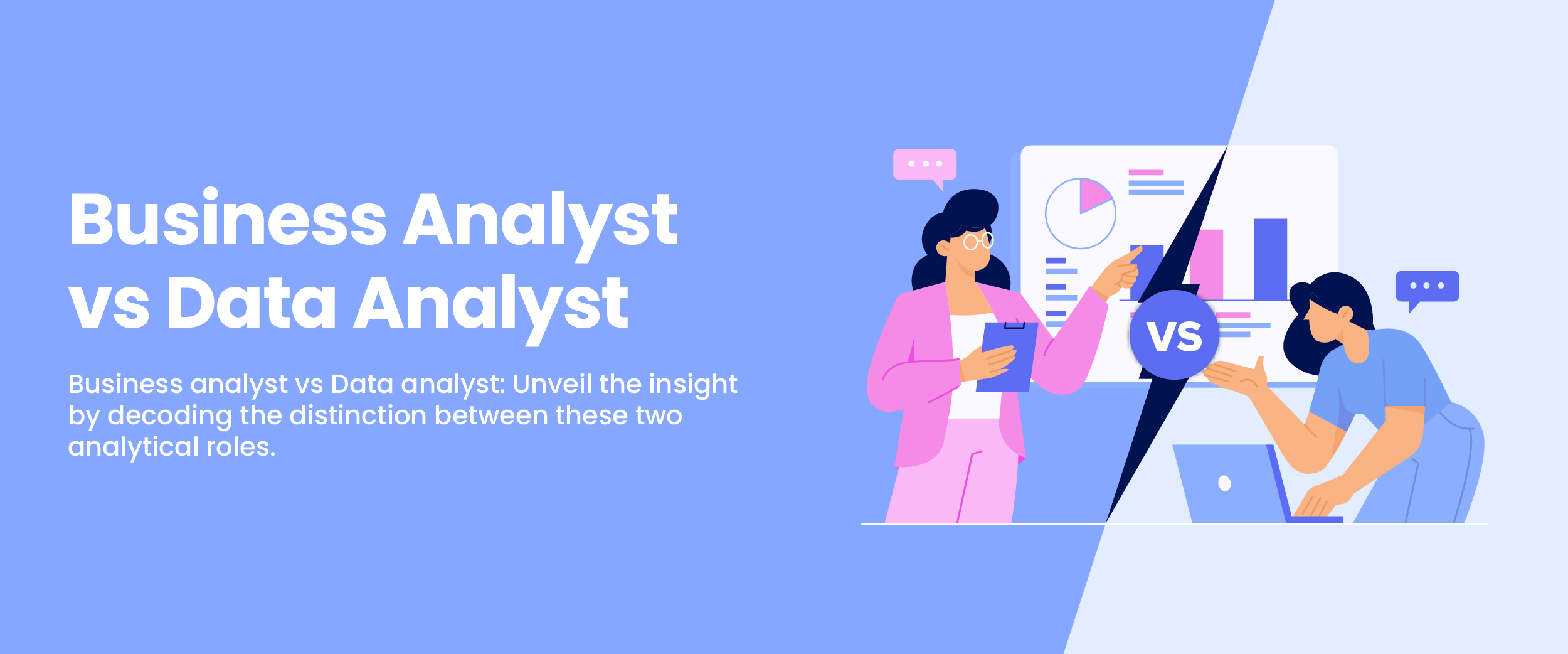Business Analyst vs. Data Analyst: The 2025 Comparative Guide
In the realm of data analytics, two roles often stand out as crucial players in the game: the Business Analyst and the Data Analyst. Though the terms may sound similar, they encompass distinct responsibilities and skill sets. Understanding the differences between these roles is essential for organizations seeking to optimize their data-driven decision-making processes. In this comprehensive blog, we dive deep into the realms of Business Analysts vs Data Analysts, unraveling their unique contributions to the field.
Business Analyst: A Brief Overview
A business analyst is a multifaceted professional who acts as a liaison between business stakeholders and technical teams. They analyze business processes, gather requirements, and propose solutions that align with organizational goals. Business analyst skills include business acumen, communication prowess, and analytical thinking. You can learn more about this field through this comprehensive business analyst course with placement guarantee.
Data Analyst: A Brief Overview
A Data Analyst is a specialist who dives deep into datasets, extracting valuable insights to support data-driven decision-making. They employ statistical analysis, data mining techniques, and data visualization tools, such as Tableau, Power BI, or custom scripts to uncover patterns, trends, and correlations. They possess a strong analytical mindset and are proficient in programming languages and database querying.
Difference Between Business Analysts and Data Analysts
The following table showcases the common differences between business analysts and data analysts.
Business Analyst Vs Data Analyst: Other Differences
Here is an in-depth comparison between business analysts and data analysts based on their salaries, responsibilities, and tools and techniques used.
| Aspect | Business Analyst | Data Analyst |
| Focus | Understands business processes and requirements. | Analyzes data to uncover insights and patterns. |
| Primary Responsibilities | Elicits and documents requirements to propose solutions. | Gathers, cleans, analyzes data, and presents insights. |
| Skills | Business acumen, communication skills, and problem-solving skills. | Statistical analysis, data manipulation, and programming skills. |
| Business Knowledge | Strong understanding of industry, organization, and domain. | Familiarity with relevant industry and data-related concepts. |
| Technical Skills | Proficient in tools for requirements management. | Knowledge of statistical software, programming, and databases. |
| Analysis Techniques | Business process modeling and data flow diagrams. | Statistical analysis, data mining, and data visualization. |
| Deliverables | Requirements documents and process flow diagrams. | Reports, dashboards, and data visualizations. |
| Stakeholder Interaction | Collaborates with business units and technical teams. | Engages with stakeholders to understand data requirements. |
| Decision-Making Support | Provides insights for business process improvements. | Supports data-driven decision-making. |
| Project Management | Assists in project planning and tracking. | Collaborates with project teams to meet data objectives. |
| Educational Qualifications | Bachelor’s degree in Business, Economics, Finance, Information Technology, or any other relevant field. | Bachelor’s degree in Statistics, Economics, Mathematics, Computer Science, or any other relevant field. |
| Specializations | Strategy and planning, operations management, marketing and sales, financial management, information technology, supply chain management, etc. | Market and sales analysis, risk analysis, data assurance analysis, healthcare data analysis, customer analysis, data governance analysis, etc. |
| Career Path | One can begin with an entry-level Business Analyst job and gain experience to acquire more senior roles like Senior Analyst, Project Manager, or Director of Business. | One can begin with an entry-level post as a Junior Data Analyst. With experience, they can attain roles like Chief Data Officer, Director of Analytics, and Analytics Manager. |
| Compensation and Benefits | The average annual salary is 9.5 LPA with additional benefits of 80,000 per annum. | The average annual salary is 7.7 LPA with additional benefits of 85,000 per annum. |
| Top Companies Hiring | Tata Consultancy Services, Deloitte, S&P Global, EY | Accenture, Cognizant Technology Solutions, Amazon, IBM, Dell Technologies |


Business Analyst Vs Data Analyst: Other Differences
Here is an in-depth comparison between business analysts and data analysts based on their salaries, responsibilities, and tools and techniques used.
Salary
To provide a comprehensive understanding of the differences between business analysts and data analysts, let’s look at the salary comparison between the two roles.
| Role | Average Salary Range |
| Business Analyst | ₹8 Lakhs – ₹16 Lakhs |
| Data Analyst | ₹6 Lakhs – ₹13 Lakhs |
The salary ranges provided above are approximate and serve as a general reference. It is essential to consider additional factors, such as education, experience, and industry demand when evaluating salary expectations.
Roles and Responsibilities
Here is a comparison table for a better understanding of the responsibilities undertaken by both of these roles.
| Parameters | Business Analysts | Data Analysts |
| Data Collection | Work closely with stakeholders and identify the business’s pain points, inefficiencies, and areas for improvement. | Collect, organize, and clean datasets for reliable analysis and interpretation. |
| Pre-Processing of Data | Transform business needs into actionable requirements by gathering, documenting, validating, and aligning them with the organization’s goals. | Perform data normalization, aggregation, or transformation techniques to prepare the data for analysis. |
| Research and Analysis | Conduct thorough research of the business landscape to understand the latest industry trends, market dynamics, and competitive analysis. | Employ statistical techniques to uncover patterns, correlations, and trends within datasets. |
| Presentation and Communication | Act as a bridge between business units and technical teams, ensuring effective communication and collaboration. | Create compelling visualizations, dashboards, and reports that communicate insights effectively to stakeholders. |
Tools and Techniques
Business analysts and data analysts utilize various tools and techniques to fulfill their roles. Let us discuss some of them.
| Parameters | Business Analyst | Data Analyst |
| Tools | They use flowcharts, wireframes, project management software, process modeling, and documentation tools. | They use statistical software packages, like Python or R, and data visualization tools, such as Tableau or Power BI. |
| Techniques | They use techniques, such as Business Process Modeling (BPM), SWOT analysis, MOST analysis, and more. | They utilize machine learning algorithms, regression models, or other advanced modeling techniques to create data models. |
Data Analyst or Business Analyst: Which Path to Choose?
Consider your skills, interests, and goals to choose an ideal career path in data analytics.
- If you enjoy bridging business and technology, excel in stakeholder management, and understand intricate processes, you can become a Business Analyst. According to a recent study, the demand for Business Analysts will increase by 14% from 2020 to 2030. This means the field will continue to grow with plenty of job opportunities for individuals.
- If you have a thirst for data, strong analytical and statistical skills, and love diving into complex datasets, you can pursue a career as a Data Analyst. It is one of the most promising career options with 25% growth in employment opportunities by 2030. Therefore, if you are looking for a stable and growing career, you can become a Data Analyst.
Get a confirmed ₹35,000 total stipend on your first internship with our data analyst placement guarantee courses.
Conclusion
In the dynamic world of data analytics, Business Analysts and Data Analysts play instrumental roles in driving data-driven decision-making. Although their shared foundation lies in the realm of data, they diverge significantly in terms of their focus areas, objectives, and deliverables. Understanding the Business Analysts vs Data Analysts differences is extremely important for making informed decisions.
Did you find this blog interesting? Which role, out of these two, aligns with your career aspirations? Let us know in the comments below. To know more about a Business Analyst in detail and how to pursue a career in this field, check out how to become a Business Analyst.
FAQs
By augmenting their skill set with technical expertise, statistical knowledge, and data analysis prowess, business analysts can seamlessly transition into the role of a data analyst.
Business analysts excel at comprehending business processes, eliciting requirements, and bridging the gap between business and technology. On the other hand, data analysts specialize in analyzing data, extracting insights, and presenting findings to drive data-driven decision-making.
Remuneration for data analysts and business analysts can vary depending on factors, such as experience, industry, and location. Generally, data analysts tend to have a slightly higher earning potential due to the specialized skill set and advanced technical knowledge required for data analysis.
Coding skills are not typically a prerequisite for business analysts. However, having a basic understanding of programming concepts can prove advantageous in certain scenarios.







